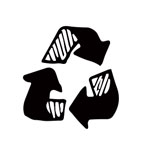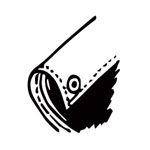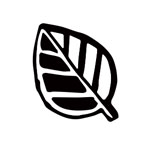This page provides more information about some of the materials used in the products we sell. Knowing about labelling on garments is important for the conscientious shopper so we've included some useful related resources on our links page.
The production process of a finished garment will always involve a degree of environmental impact. There is however, a large range of materials and processes which can lessen the negative effect on the planet, when compared to conventional clothing and without the use of animal products too. Supporting and investing in companies who use more environmentally conscious materials and production processes can contribute to the wider shift to more sustainable fashion.
The best approach to minimise environmental impact is to buy better quality items from companies you trust, buy less, look after what you buy and re-use, recycle and repair what you have. Much of the environmental impact of textile goods comes from their care. Some materials (such as Lyocell) are softer than others so there is no need for fabric softener which can weaken and damage a material too, so even 'manufactured' fibres can be considered to be a greener choice.
 Bamboo
Bamboo
Smooth and luxurious to the touch, bamboo fabric keeps you cool in high temperatures, while warming you when it’s cold. The fastest growing plant in the world, it thrives naturally without need of fertilisers or pesticides and needs very little water. Its yield is 10 times that of a cotton crop, which is great news for the soil too, however bamboo fabric production will often involve a chemical pulping process.
 Cork
Cork
Cork is a 100% sustainable raw material. It can be harvested from cork oak trees every 9 years without harming or killing the trees and once harvested, the bark regenerates. Cork trees can live 170 to 250 years on average too, so it’s a great renewable and sustainable resource. Its versatility means that there is clothing fabric made from cork, but at the moment you will only find cork on our bags and accessories, and some of our footwear. Those products require the cork to be fixed to another material, generally using adhesives.
 Cotton
Cotton
Cotton is the most popular fibre in the World for clothing, and it is the oldest vegetable textile fibre that exists after linen. Grown in tropical and subtropical regions, it is used to make a versatile, soft, light, strong and breathable textile that is also able to absorb moisture. If an item is 100% cotton, it will often shrink slightly when washed so we’d recommend you wash at a lower temperature – typically 30 degrees – to minimise shrinkage. Cotton is a very pesticide and water dependent crop, so we buy organic-cotton products wherever possible, and encourage suppliers to replace their non-organic cotton with organic cotton.
 Cotton (Organic)
Cotton (Organic)
Organic cotton is considered by many to be the most eco-friendly fabric behind hemp. Organic cotton has all the same properties as its traditional non-organic variety, but by choosing organic cotton you avoid the negative consequences of pesticide and insecticide use in farming that result in reduced soil fertility, frequent water pollution, and damage to the health of cotton-pickers and animals. Added dyes can undo some of the positives in your organic products, so if you’re looking to minimise your environmental impact, the safest bet is to buy organic cotton clothing in the shades the cotton is grown in – cream, light brown and pale green.
 Hemp
Hemp
Hemp fibre comes from the cannabis Sativa plant which grows to a height of 4 metres even in poor soil, giving a yield 3 to 4 times more than most other textile crops (such as cotton) without the need for chemicals. It is one of the most useful plants, and a stronger material than cotton. When it is grown and processed without chemicals and when it is sourced from old existing plantations so as not to lose more habitat, it is arguably the most eco material. The main issue is that there are relatively few products available made from hemp that tick all the boxes with regard to aesthetics, design, and being manufactured under good working conditions.
 Linen
Linen
Linen yarns come from Flax plants - a crop that requires very little pest-controlling chemicals. It’s very breathable, ideal in warm weather and has a distinguished natural look and feel. It’s also best when it’s a little wrinkled, so you can conserve energy by not ironing it! As with any organic material, look for linen in its natural shades, or dyed with natural dyes. The Flax plant doesn’t require a lot of energy or water resources to produce, and the entire plant is used to make linen, leaving no waste. Linen clothing is also naturally biodegradable and recyclable.
 Microfibre (faux-leather & faux-suede)
Microfibre (faux-leather & faux-suede)
Some of our footwear is made from microfibre. It is a purpose-made, lightweight, durable, breathable material that looks smart and is a great alternative to leather. There is a huge range of microfibres, from the faux-suedes that are soft to touch and act very much like regular suede although generally easier to clean, through to the hard wearing leather-look microfibre which 'breaks-in' and creases like leather whilst having the additional advantages of being water-resistant and lighter than leather. Microfibres will have an oil/polyurethane element and oil is a limited resource, however the uppers of our footwear don't contain any P.V.C. There is a common assumption that leather goods are more natural or better for the environment than synthetic alternatives and that leather is just a by-product of the farming industry anyway. This isn’t the case. Leather makes up between 10% & 15% of the total financial 'value' of an animal, and the process of making standard leather involves intensive water usage and very harmful chemicals.
 Rayon
Rayon
Rayon is a biodegradable fabric made from regenerated sustainable tree cellulose - it is not synthetic. Invented in Paris over 100 years ago, its name derives from a word meaning 'Rays of Light' because it’s so good at showing colours without needing hard dyes and softeners, but it does require a chemical pulping process to produce the material.
 Reclaimed / Upcycled Materials
Reclaimed / Upcycled Materials
A reclaimed material is 'waste' that has been saved from landfill to be reused. If something is upcycled, the waste material is being used again with a new purpose, giving it a greater value than its original state. Upcycling is designed to work to benefit the environment, encouraging people to think of new and innovative ways to reuse materials rather than discarding them.
 Recycled / Fair-trade Rubber
Recycled / Fair-trade Rubber
Some of the shoes we sell have soles which are made using recycled rubber from old car tyres. Others (such as those made by Ethletic), use Fair-trade natural rubber for the soles, from rubber tree plantations which are internationally certified by the Forest Stewardship Council.
 Recycled Polyester / Recycled Plastics
Recycled Polyester / Recycled Plastics
Some of the fabrics used in our clothing is made from post-consumer recycled polyester, this means that the fabric is actually made from re-processed waste plastic like drinks bottles or food containers. Reclaimed plastics are also used to make some of our shoes and bags.
 Tarpaulin (recycled)
Tarpaulin (recycled)
Some of our products are made from up-cycled lorry curtains that are being thrown out after thousands of miles on the road networks of Europe. This thick, waterproof material would otherwise end up in landfill and produces a unique look due to logo designs left on the material from its previous life.
 Tencel®
Tencel®
Tencel® is the brand name for Lyocell, a form of rayon. It is an award-winning eco-fibre made from tree cellulose farmed on wasteland. It is highly economical in its use of energy and natural resources, it is bio-degradable and it looks and feels great. It’s made from wood pulp, so it’s also recyclable. It doesn’t get bleached and it’s naturally wrinkle-free, so you don’t need to waste time or energy ironing it! Not all Lyocell fabric is made from sustainable wood, though, so check labels carefully, and as usual, try to find a product that’s been dyed with a low-chemical or vegetable colourant. As with many materials, Tencel production uses chemicals in the pulping process, but this is done in a 'closed-loop' system, so is benign – the thing that makes Tencel special is the recovery and reuse of up to 99.8 percent of the solvent used in that process, and the remaining emissions are broken down in biological water treatment plants. In fact, the solvent is not acidic, does not remain in the fibre, and has been proven harmless in dermatological and toxicological tests.
